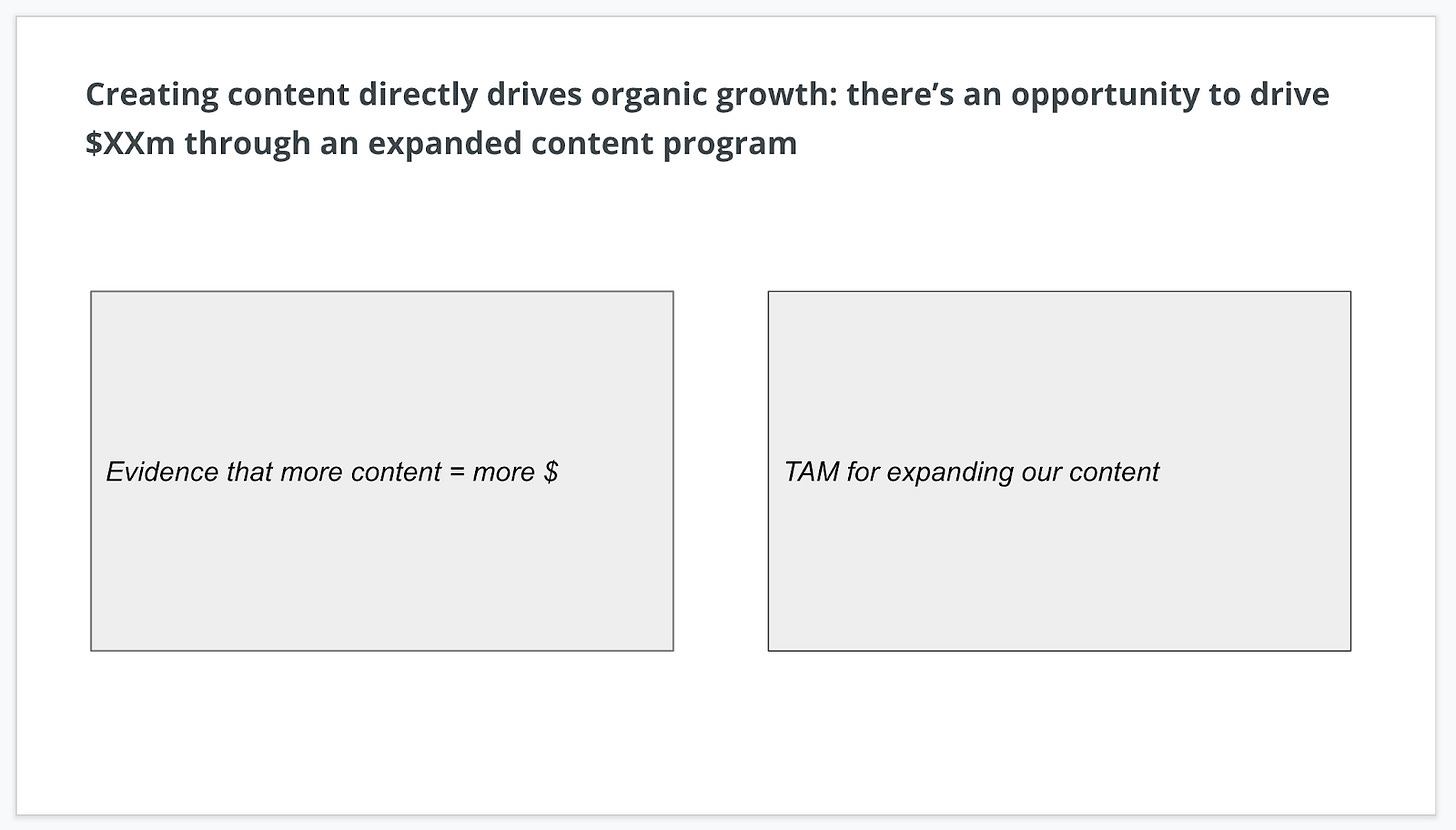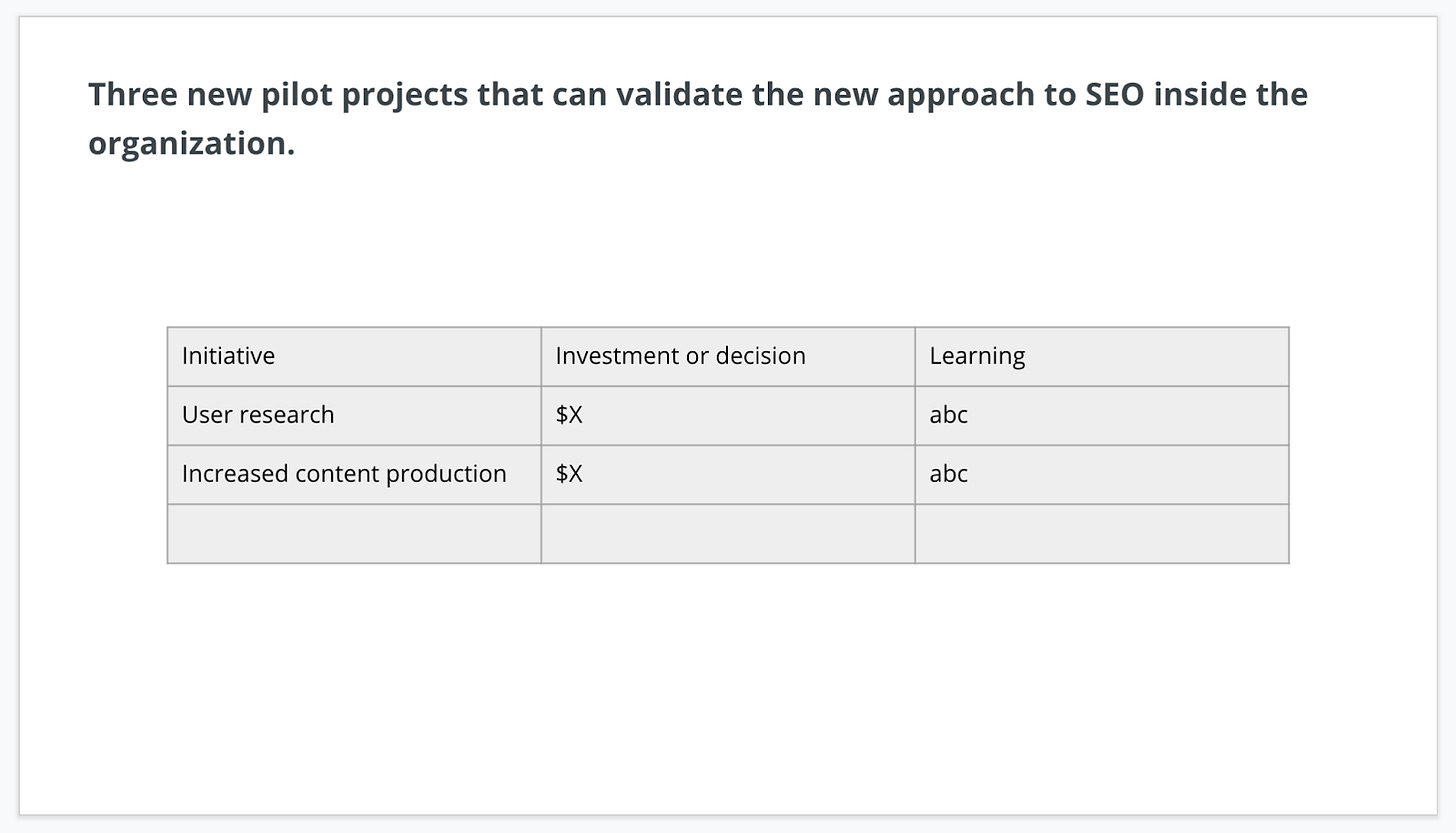How to convince execs to care about SEO
Getting buy-in through education and advocacy
Hey everyone: quick update. This email has slowed down because I’ve been traveling with my family. The email schedule is likely going to continue to be a little sporadic over the next couple of months.
In the meantime I wrapped up teaching the first SEO MBA course cohort - thanks to all of the students who took a bet on the course beta! Teaching the course live was a big learning experience for me and it absolutely made the course content stronger and highlighted some gaps where the content can be expanded and improved.
At the same time the feedback from the students really blew me away and absolutely validated the course idea so I’m working hard behind the scenes to refine and polish the curriculum and hopefully launch it sometime in the fall. I know a lot of folks wanted to join the beta and didn’t get in so please hang tight - the full course is coming soon!
Reminder: the SEO MBA is an email newsletter all about leadership, management and consulting skills for SEO professionals written by me, Tom Critchlow. Thanks for being here.
One of the major complaints I hear from SEO professionals is that their organization doesn’t take SEO “seriously”. I’ve seen first hand plenty of in-house teams who are marginalized and starved for budgets and buy-in.
This marginalization comes from two basic root causes:
The executive team doesn’t believe that SEO can be a strategic growth channel
The executive team has an out-dated perspective of what SEO is
Instead of getting frustrated with this - you should be running a campaign of education and stakeholder buy-in to make people understand what SEO is and, more importantly, what it could look like.
What you’re looking to do is build excitement for an SEO program. Organizations (and especially executives) are hungry for initiatives and programs that people are excited to work on. Especially those that have a chance at outsized growth.
Changing an organization’s culture is fascinatingly difficult and there are many different approaches to take. Today let’s sketch out what a presentation could look like that might educate people on what modern SEO should be, while also directly addressing the assumptions around SEO as a growth channel.
A Presentation Outline to Advocate for SEO
Here’s how I’d go about advocating for SEO inside an organization. It’s one part “hey SEO is important!” and one part “SEO isn’t technical tweaks, it’s user experience!”.
Slide 1: The biggest numbers you can find
This slide is designed to set the stage and provide a shared context that “organic traffic matters”. Don’t assume that executives actually know this! You might separate out branded / un-branded here or site sections. Frame this slide in the way that executives think about the business - i.e. segment by business units and product lines, not page types and sub-domains.
Slide 2: Directly separate “SEO activity” from “organic traffic”
One common executive misconception around SEO is that the SEO activity is only marginally affecting “organic traffic”. This slide is designed to directly address that by trying to carve out what percentage of organic traffic is “on the table”.
The floor here is the worst case - what might happen if we don’t invest in SEO? Some good options to calculate this number:
If organic traffic is declining (or competitors are growing faster than us) then what revenue loss is that over 1-2 years?
If a competitor suffered from an “algo hole” swing - if that happened to us what percentage of revenue is that?
The ceiling is the best case - and here we should rely on top down TAM (total addressable market) thinking (as outlined in previous email here). Don’t look at what pages, keywords and traffic we have today but instead look at some larger but analogous competitor and show what growth is potentially available on the table.
If you have history inside an organization this could be a good spot to show the impact of some large SEO initiatives - especially circling back on projects that shipped a while ago and showing the multi-year growth impact of them (executives tend to have a very short term memory, don’t be afraid to remind them of the hits!).
Note: this slide might get busy, so could easily be two slides, one for the floor and one for the ceiling. This could also be a good use of the appendix to expand on these models in more depth to show the working out of where these numbers come from.
Slide 3: What is modern SEO?
This slide directly addresses the misconception that “SEO is just a set of technical tweaks”. Here your specific slides will likely be tailored to the industry and situation you’re in but in my opinion the only way to communicate about SEO at the executive layer is through the language and vision of consumer experience.
If your SEO program is reporting to the C-suite through initiatives like sitemaps, schema, link building and keyword research then you're often going to face the strategic marginalization that I described above.
Finding evidence for the link between consumer experience and SEO might be as simple as a quote from the quality rater guidelines. This was a real quote I used in a client presentation:
Or it could be showing traffic & revenue gains from competitors that have a superior consumer experience.
Then the job is to articulate the gap between our consumer experience relative to competitors. This could be through user testing, market research or just simple feature analysis (their product pages have X, Y, Z, we have X only).
Evidence is the key word for this slide - we’re not necessarily looking for something exhaustive or completely conclusive but equally we’re not looking for something that’s just “our opinion”.
And be very careful overreaching: a common failure mode I see for SEOs is thinking that all consumer experience matters for SEO. This is clearly not the case - we might have opinions about the logged in consumer experience or the signup funnel but it’s important not to overreach and instead focus on those aspects of consumer experience that most directly impacts SEO (i.e. landing page consumer experience).
Slide 4: How do we scale?
This slide doesn’t have to be about content creation - it could be about scaling user reviews for example for a UGC site. But the key point builds on the last slide and directly addresses that misconception that SEO is about “technical fixes”.
Again: here the key is not necessarily to be grounded in what we have today but rather what the total opportunity is. Demonstrating the link between more content = more traffic should be fairly straightforward (and often obvious?) but you should push yourself for a “full accounting” here to get to a net revenue number. How much does it cost to produce content? If we know that then hopefully we can say something more useful than more content = more traffic but rather more content = more revenue.
Slide 5: So what?
So far we’ve mostly focused on education, but here we start to get to actual advocacy: what change do we want to see? Are we advocating for an increased budget? Are we advocating for specific investments? Increased headcount?
Importantly - ensure that the level of investment you’re asking for is framed at the same level as the growth opportunity you’ve outlined. This keeps the deck logically consistent and believable. Outlining a “big opportunity” such as this is a hammer, don’t use it to crack a tiny nut like fixing some XML sitemaps…….!
Alt slide 5: new behaviors via pilot projects
Maybe the organization isn’t ready to make a big investment. This could be because the culture isn’t bought in yet, or it could be a more pragmatic reason like budgets are already allocated for the year / quarter.
In this case you might be advocating for new behaviors - i.e. if the organization today doesn’t think about SEO as consumer experience what is a small pilot project to get more information and prove that link? Are we asking for a small budget to do user research? Or to run some small changes on one part of the site?
The key here is that the small pilot projects need to ladder back up directionally to the big opportunities ahead. What are the small steps that will give us insight, information or data to come back to the table in 3-6 months and advocate for a real budget?
Here we might be advocating for small budgets, or we might just be advocating for permission to spend time on this (from our team and/or other teams). We’re looking for explicit buy-in to build support for the pilot that will translate into bigger investments down the line.
Slide 6: Proof that competitors do this
This might seem weird but executives are often terribly risk-averse. Especially to “good sounding ideas that no one else is doing”. Executives get pitched things all the time (and recall from a previous email that the CEO’s job is to say no) so what we’re looking to do with this slide is demonstrate that this investment is normal and that competitors (or analogous companies) are already operating this way.
A simple LinkedIn search might show that a competitor has a bigger SEO team, or looking at the velocity of content or changes at competitors we can extrapolate that they’re investing in these kinds of projects. This essentially de-risks and normalizes this investment in the minds of the executive team.
Optional slides: Case studies
Depending on the audience, their attention span and their level of knowledge I’d likely add some slides to this presentation throughout to showcase competitors or analogous websites that are doing the things we're advocating for.
The key here is not to assume that executives are actually paying attention to what competitors are doing - especially at the level of SEO and content. Showing a competitor case study has two strong effects:
It proves that large SEO growth is possible
It shows a direct threat of competitor growth
I’ve intentionally kept these slides generic to prevent people copy and pasting them - in reality you’ll need to do a fair amount of customization both for your business and for the level of education / buy-in that you have but hopefully the structure and mindset is useful.
What have you used that works to increase the awareness, education and buy-in for SEO across your organization?












Is there a reason you use the word "consumer behaviour" rather then ?user behaviour"
Yessss! Always great to see others referencing the value of presenting the TAM! 🙌